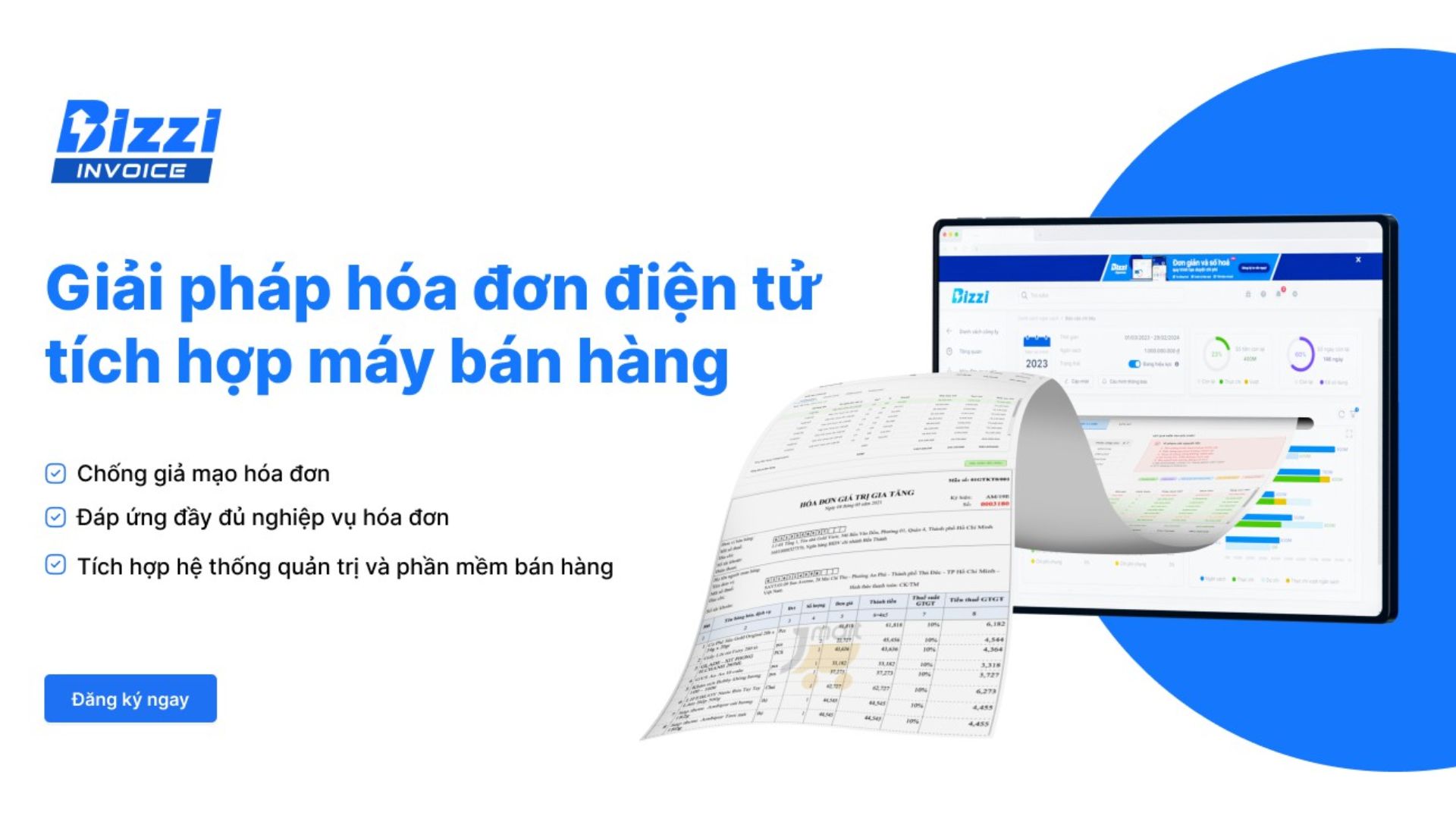Electronic invoices are indispensable documents in the accounting and financial activities of every business. However, errors in the process of creating and issuing invoices are inevitable. From entering incorrect tax codes, product names, amounts, to more complex errors, each case has its own way of handling according to current legal regulations.
This article by Bizzi will be a comprehensive guide, guiding you How to adjust incorrect electronic invoice content exactly, strictly Decree 123/2020/ND-CP and Circular 78/2021/TT-BTC. Let's find out now to ensure that your business's invoices are always valid, avoiding any unnecessary legal risks!
1. Legal regulations on adjusting erroneous electronic invoices
Issuing invoices with incorrect content can cause many legal consequences, directly affecting tax declaration, payment and financial reporting. Therefore, the law has very clear regulations on how to handle it to ensure transparency and compliance.
1.1. Important legal documents to know
Decree No. 123/2020/ND-CP
- Issued on October 19, 2020, is the core legal document regulating invoices and documents.
- Article 19 This Decree specifically stipulates the Principles for handling erroneous electronic invoices, including 3 main methods:
- Create adjustment invoice: Modify part of the incorrect content.
- Alternative Invoicing: Completely replace the old invoice.
- Cancel invoice and create new: Applies to cases where invoices have not been sent.

Circular No. 78/2021/TT-BTC
- Issued on September 17, 2021, detailed instructions on Decree 123.
- Article 7, Clause 1 This Circular clarifies the cases of errors that need to be adjusted and the corresponding handling for each situation.
1.2. Summary of error cases and handling principles
Below is a summary table of common error situations and how to handle them according to regulations:
| In case of error | Handling method according to Article 19 of Decree 123/2020/ND-CP | Important Note |
|---|---|---|
| Incorrect buyer information (name, address) but No wrong tax code and does not affect the amount. | The seller only needs to notify the buyer and send Form 04/SS-HĐĐT to the tax authority. No need to create new invoice. | Must notify the buyer so that both parties are informed. |
| Wrong about tax code, amount, tax rate, tax amount, or non-conforming goods. | Choose 1 of 2: Create adjustment invoice OR Invoice replacement. | There must be agreement between both parties. The adjustment/replacement invoice must clearly state the original invoice number… |
| The entire invoice content is incorrect (serious error). | Should Create a replacement invoice. | The replacement invoice must have complete and correct information and clearly state “Replacement for invoice number… symbol… date…”. |
| Invoice but not sent to buyer. | Cancel invoice created and issued new invoice. | Invoice cancellation notice on the system according to Form 04/SS-HDDT. |
| The invoice has been declared for tax but there is an error. | Set up Adjustment/Replacement Invoice and do supplementary declaration. | Supplementary declaration is made in the current tax declaration period. |
1.3. Standard 5-step process for handling incorrect invoices
To ensure absolute compliance, businesses need to follow the following 5-step process:
- Step 1: Identify the type of error: Analyze the invoice carefully to determine exactly which error is involved.
- Step 2: Agreement with the buyer: Contact and agree with the customer on the treatment plan (adjustment or replacement), should make a record of agreement.
- Step 3: Create an adjustment/replacement or cancellation invoice: Perform operations on electronic invoice software.
- Step 4: Send error notification (Form 04/SS-HDĐT): Send notification to tax authorities via the General Department of Taxation Portal.
- Step 5: Additional tax declaration: If the error affects the amount of tax payable, a supplementary declaration must be made for the relevant tax period.
Complying with this process not only helps businesses avoid legal risks but also maintains transparency and accuracy in accounting books.

2. Instructions for handling each specific invoice error case
Below is a detailed guide for each error situation that a business may encounter:
2.1. Electronic invoices have been assigned a code by the tax authority but have not been sent to the buyer.
Treatment options: Cancel the issued invoice and issue a new invoice in its place.
Processing procedure:
- Step 1: On the electronic invoice software, select the "Cancel" function for the erroneous invoice.
- Step 2: Prepare a notice of incorrect invoice and send it to the tax authority as follows: Form No. 04/SS-HDDT.
- Step 3: Create a new electronic invoice, sign it and send it to the tax authority to get a code.
2.2. Invoice sent, wrong name, buyer address (but correct tax code and other information)
Treatment options: No need to issue a replacement/adjustment invoice. The seller only needs to notify the buyer and send Form 04/SS-HĐĐT to the tax authority for recording.
2.3. Invoice sent, incorrect tax code, amount, tax rate, tax amount or goods...
Treatment options: Businesses can choose one of the following two ways (need to have agreement with the buyer):
- Method 1: Create an adjustment invoice: The adjustment invoice must clearly state “Adjustment (increase/decrease) … for invoice number… symbol…”. Clearly state the adjustment content (for example: adjust to decrease the price of goods by 1,000,000 VND).
- Method 2: Create a replacement invoice: Create a new invoice with the correct content and clearly state “Replacement of invoice number… symbol…”. The replacement invoice will invalidate the old invoice.
2.4. Cancellation or termination of service provision
Treatment options: Seller performs cancel electronic invoice created (if the transaction is completely canceled) and notify the tax authority of the invoice cancellation according to Form No. 04/SS-HDDT. The two parties need to have a clear agreement on the cancellation of this transaction.
2.5. Handling of erroneous paper invoices (created before conversion)
Treatment options: If the enterprise has switched to electronic invoices according to Circular 78 but discovers that the old paper invoices are incorrect, the handling will still comply with the provisions of Circular 39/2014/TT-BTC. The two parties will make a record and issue an adjustment/replacement invoice (still a paper invoice if it still exists, or agree on another handling).
2.6. When the tax authority discovers and reports errors
Treatment options: Enterprises must review according to the tax authority's notice and make an adjustment/replacement invoice, then send Form 04/SS-HĐĐT to respond to the tax authority.
2.7. Adjustment or replacement invoices continue to have errors
Treatment options: Subsequent processing must follow the same format as the first time. For example, if an adjustment invoice was issued the first time and an error is discovered the second time, an adjustment invoice must still be issued for the original error invoice.
2.8. Errors in the invoice data summary table
Treatment options: For businesses without a CQT code, if errors are detected on the data summary table, the seller only needs to send adjustment information for the information declared on that summary table.
3. Notes when adjusting incorrect electronic invoices
To ensure a smooth adjustment process, accountants should keep in mind the following important points:
Agreement with customer before implementation
This is the first step. Always discuss and make a written agreement with the buyer to agree on a solution. This helps avoid disputes and ensures transparency.
Deadline for submitting Form 04/SS-HDDT
Businesses must pay Form 04/SS-HĐĐT to the tax authorities at the latest last day of term tax return VAT Adjustment/replacement invoices may be issued. Late submission may result in administrative penalties.
Rules for recording value on adjusted invoices
- Adjust UP: Write positive sign (+).
- Adjust DOWN: Enter negative sign (-).
For example: Original invoice is 10 million, actual is 9 million. Adjusted invoice will record: Adjusted decrease in goods price, value: -1,000,000 VND.
Mandatory additional tax declaration if there is any impact
Any adjustment/replacement invoice related to goods or tax will change the tax liability. The accountant must perform supplementary tax declaration of the original period with incorrect invoice.
Store all relevant documents
Incorrect invoices, agreement minutes, adjustment/replacement invoices are all important accounting documents. Enterprises must fully archive them according to the provisions of the Accounting Law to serve future inspections and audits.
Use smart electronic invoice software
To minimize errors, businesses should invest in reputable e-invoice software. Solutions such as B-Invoice (by Bizzi), MISA, Viettel Invoice... not only help check for errors before issuing but also support quick and correct invoice adjustment/replacement.
4. Bizzi electronic invoice software solution – Automation, error reduction
B-Invoice Bizzi's is a software solution Electronic invoice designed to thoroughly solve the difficulties in managing and processing invoices, helping businesses automate processes, minimize errors and save costs.
- Recognized by the General Department of Taxation: Comply with 100% Decree 123/2020/ND-CP and Circular 78/2021/TT-BTC.
- Easy integration: Seamlessly connect with accounting software, ERP software popular, helps synchronize data, saves time.
- Intelligent error handling: Provides features for adjusting, replacing, and canceling invoices with just a few clicks, ensuring compliance with Tax authority procedures.
- 10 year safe storage: Ensure safety and security according to ISO 27001 standards and meet the storage regulations of the Accounting Law.
- Auto update: Always update the latest changes from the Tax authorities, helping businesses confidently comply with the law.

Instructions on how to create an adjustment invoice on Bizzi software:
Applies to invoices in “Issued” status.
Step 1: In the menu “Manage invoices” → “Sales invoices”, find the invoice to be processed and select the “Adjust invoice” function.
Step 2: Fill in all information in the adjustment invoice form (select adjustment type, write reason and adjustment value), then click “Create new”.
The system will automatically create a new adjustment invoice with the necessary information and return to the invoice list screen.
Bizzi has been trusted by more than 1,000 large businesses, including Grab, GS25, Circle K, Tiki, Guardian... with a total monthly invoice processing value of more than 300 million USD.
5. Frequently Asked Questions (FAQ)
1. Does the adjustment/replacement invoice require the buyer's signature?
According to current regulations, the buyer's digital signature is not required on the adjusted/replaced electronic invoice. However, a written agreement between the two parties is necessary as a legal basis.
2. What should I do if I accidentally delete an incorrect invoice on the software?
“Deleting” an issued invoice is not in accordance with regulations. You need to perform the “Cancel”, “Adjust” or “Replace” operations. If you make a mistake, contact the software provider for support and to ensure that the data is reported correctly to the tax authorities.
3. What to do if the invoice is incorrect but the tax declaration deadline is overdue?
You still proceed to issue the adjustment/replacement invoice at the present time. After that, you must issue a supplementary VAT declaration for the tax period with the error and pay the tax difference (if any) and late payment interest (if any).
4. Can I create 1 adjustment invoice for multiple erroneous invoices?
No. Each adjustment/replacement invoice is only issued for ONE erroneous invoice.
6. Conclusion
Correct and legal handling of erroneous electronic invoices is key to ensuring transparency and compliance with the law. Mastering the regulations in Circular 78/2021/TT-BTC and Decree 123/2020/ND-CP is a mandatory requirement for all accountants.
To simplify the process and minimize risks, applying technological solutions such as electronic invoice software Bizzi is a smart choice. Bizzi not only helps businesses automate invoice processing but also ensures safety and transparency, contributing to improving operational efficiency and optimizing financial and accounting processes.
See more:


